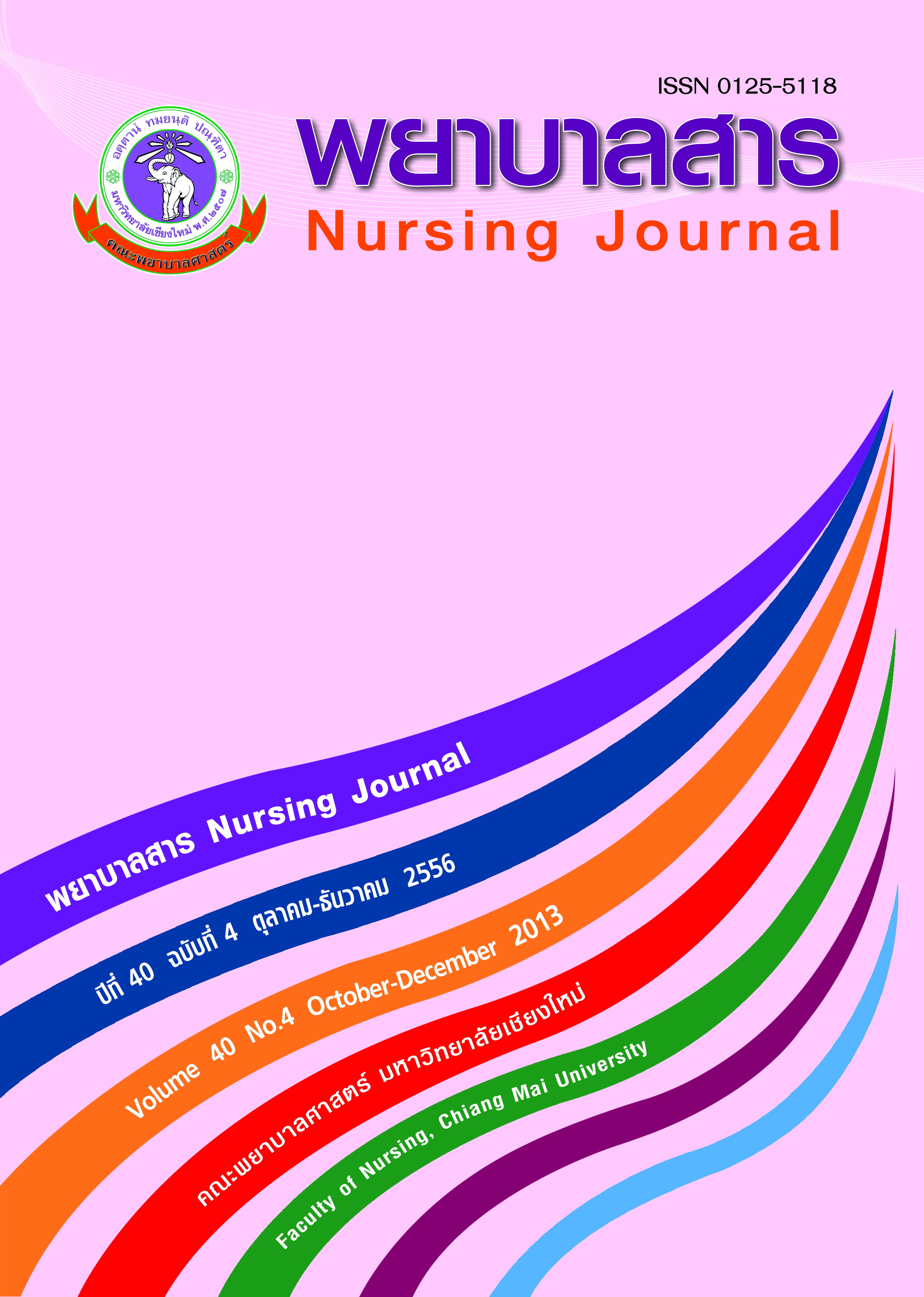การดำเนินงานการป้องกันการติดเชื้อในโรงพยาบาลสังกัดกระทรวงสาธารณสุข สาธารณรัฐประชาธิปไตยประชาชนลาว
Keywords:
Infection Prevention, Ministry of Health Lao People's Democratic Republic, Nosocomialinfection, Needs of support, ObstaclesAbstract
บทคัดย่อ
การดำเนินงานการป้องกันและควบคุมการติดเชื้อในโรงพยาบาลมีความสำคัญและมีความจำเป็นในการลดการติดเชื้อในโรงพยาบาล การวิจัยเชิงพรรณนานี้มีวัตถุประสงค์ เพื่อศึกษาการดำเนินงานการป้องกันและควบคุมการติดเชื้อในโรงพยาบาลสังกัดกระทรวงสาธารณสุข สาธารณรัฐประชาธิปไตยประชาชนลาว (สปป. ลาว) รวมทั้งอุปสรรค และความต้องการสิ่งสนับสนุนในการป้องกันการติดเชื้อในโรงพยาบาล ประชากรที่ศึกษาคือ ผู้อำนวยการโรงพยาบาลหรือผู้รับผิดชอบด้านการควบคุมการติดเชื้อในโรงพยาบาลสังกัดกระทรวงสาธารณสุข ทั้ง 3 ระดับ คือโรงพยาบาลส่วนกลาง โรงพยาบาลจังหวัดและโรงพยาบาลอำเภอ จำนวน 118 คน รวบรวมข้อมูลระหว่างเดือนสิงหาคม ถึงเดือนกันยายน พ.ศ. 2555 เครื่องมือที่ใช้ในการรวบรวมข้อมูลได้แก่ แบบสอบถามการดำเนินงานการป้องกันการติดเชื้อในโรงพยาบาล ขององค์การอนามัยโลก (World Health Organization [WHO], 2011a) ผู้วิจัยได้แปลเป็นภาษาไทยและแปลเป็นภาษาลาวจากนั้น นำไปทดลองใช้กับกลุ่มตัวอย่าง จำนวน 9 คนเพื่อทดสอบความเป็นไปได้ วิเคราะห์ข้อมูลโดยสถิติเชิงพรรณนาและจัดหมวดหมู่คำตอบ
ผลการวิจัย พบว่า
การดำเนินงานการป้องกันการติดเชื้อในโรงพยาบาล สังกัดกระทรวงสาธารณสุขสปป. ลาว 8 ด้านพบว่าด้านการประสานงานกับหน่วยงานสาธารณสุขอื่นและด้านสิ่งแวดล้อม มีการปฏิบัติที่สูงใกล้เคียงกันโดยพบการปฏิบัติร้อยละ 82-93 และร้อยละ 72-89 ตามลำดับ ส่วนด้านที่เหลือ ได้แก่ ด้านโครงสร้างองค์กรการดำเนินงานการป้องกันติดเชื้อ ด้านแนวทางปฏิบัติการควบคุมการติดเชื้อ ด้านทรัพยากรบุคคล ด้านการเฝ้าระวังการติดเชื้อในโรงพยาบาล ด้านการสนับสนุนทางห้องปฏิบัติการ และด้านการติดตามและประเมินผล พบว่าโรงพยาบาลอำเภอมีการปฏิบัติเพียงร้อยละ 20-43 ซึ่งตํ่ากว่าโรงพยาบาลจังหวัดและโรงพยาบาลส่วนกลางอุปสรรคในการดำเนินงานการป้องกันการติดเชื้อในโรงพยาบาลทุกระดับที่ พบมากที่สุดคือ ด้านงบประมาณและด้านวัสดุอุปกรณ์ คิดเป็นร้อยละ 89 เท่ากัน ด้านอัตรากำลังคน คิดเป็นร้อยละ 86 และด้านการบริหารร้อยละ 78ความต้องการสิ่งสนับสนุนในการดำเนินงานการป้องกันการติดเชื้อในโรงพยาบาล ด้านงบประมาณ และด้านวัสดุอุปกรณ์พบร้อยละ 98 เท่ากัน ด้านอัตราการกำลังคน ร้อยละ 95 และ ด้านการบริหาร ร้อยละ 93ผลการวิจัยครั้งนี้ชี้ให้เห็นว่า โรงพยาบาลทุกระดับใน สปป.ลาว ควรได้รับการส่งเสริมและสนับสนุนการดำเนินงานการป้องกันการติดเชื้อในโรงพยาบาล โดยเฉพาะโรงพยาบาลระดับอำเภอ
Abstract
Infection preventionin a hospital is an important and necessary activity to reduce nosocomialinfections. This descriptive research study aimed to examine the practices of infection prevention(PIP) in hospitals under the Lao People's Democratic Republic Ministry of Health. The study alsodocumented obstacles and needs for infection prevention in these hospitals. The participants were118 directors or the person responsible for infection prevention central, provincial and districtgovernment hospitals. Data were collected from August to September 2012. The Assessment Toolsfor Hospital Infection Prevention and Control Programmes developed by the WHO in 2011 wereused as a guide to develop the questionnaire used in this study. The questionnaire was translatedinto Thai and Lao by the researcher. The questionnaire was tested for usability in 9 persons. Datawere analyzed using descriptive statistics and data categorization.
The Resulf of study
The based on the 8 infection prevention components (IPC), the PIP were high in threelevels of the hospitals on the components of collaboration with other public health services andenvironment with the percentage of 82-93% and 72-89%, respectively. Where as other componentsincluding organizational structure of IPC programme implementation, infection control guidelines,human resources, surveillance of health care-associated infections, microbiology laboratorysupport, monitoring and evaluation were practiced with the percentage of 20-43% by district hospitalswhich were lower than central, and provincial hospitals.PIP obstacles, as reported by all level of hospitals, were inadequate budget and materials(89%), man power (86%), and management (78%). Needs for supporting nosocomial infectionprevention and control, as reported by all level of hospitals, were budget and materials (98%), manpower (95%), and management (93%).The findings indicate that all level of hospitals in Lao People's Democratic Republic Ministryof Health should be supported for implementing PIP, especially in district hospital.
Key words: Infection Prevention, Ministry of Health Lao People's Democratic Republic, Nosocomialinfection, Needs of support, Obstacles.
How to Cite
Issue
Section
License
บทความที่ได้รับการตีพิมพ์เป็นลิขสิทธิ์ของวารสารพยาบาลสาร
ข้อความที่ปรากฏในบทความแต่ละเรื่องในวารสารวิชาการเล่มนี้เป็นความคิดเห็นส่วนตัวของผู้เขียนแต่ละท่านไม่เกี่ยวข้องกับมหาวิทยาลัยเชียงใหม่ และคณาจารย์ท่านอื่นๆในมหาวิทยาลัยฯ แต่อย่างใด ความรับผิดชอบองค์ประกอบทั้งหมดของบทความแต่ละเรื่องเป็นของผู้เขียนแต่ละท่าน หากมีความผิดพลาดใด ๆ ผู้เขียนแต่ละท่านจะรับผิดชอบบทความของตนเองแต่ผู้เดียว






